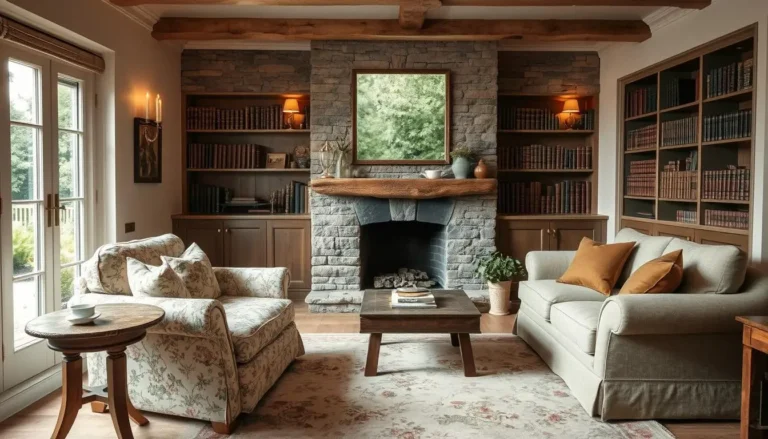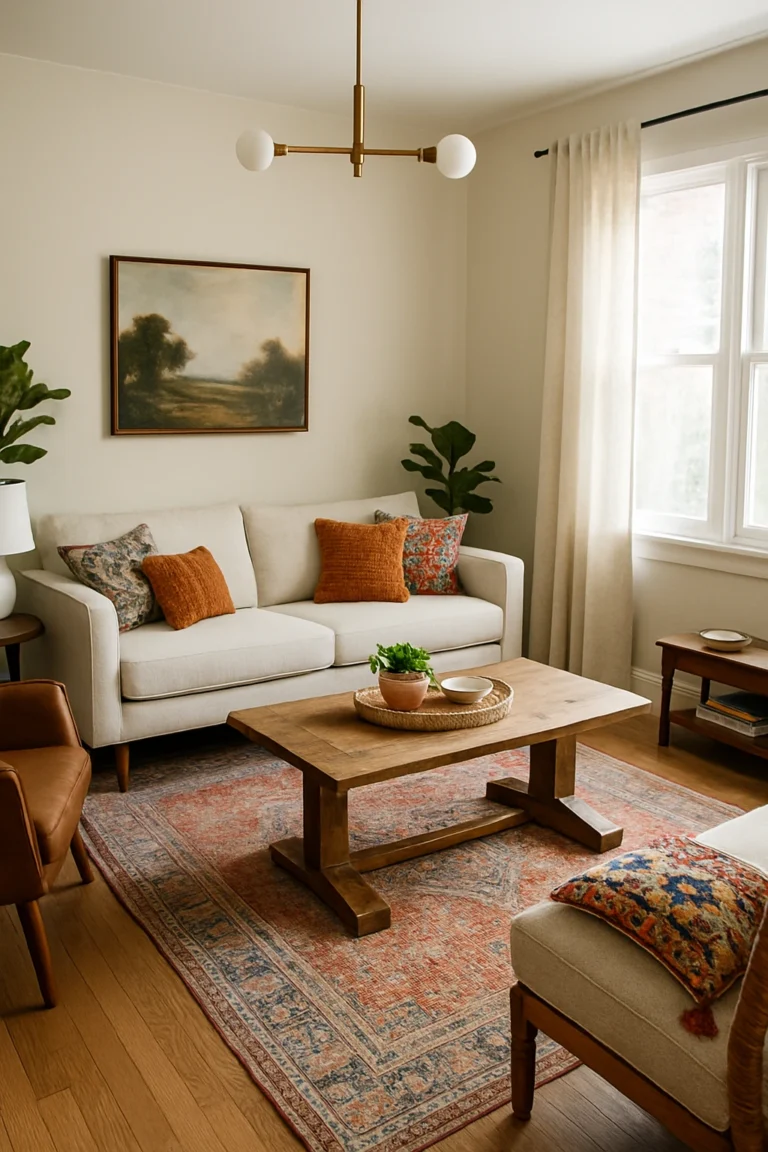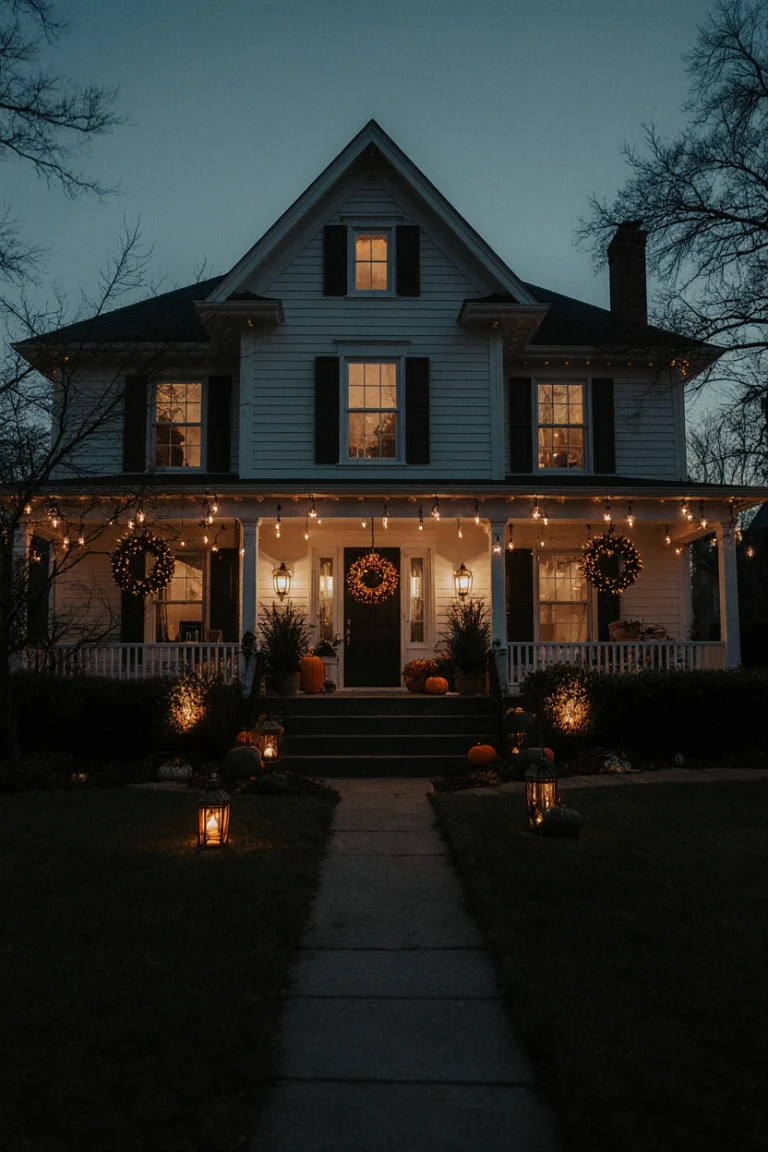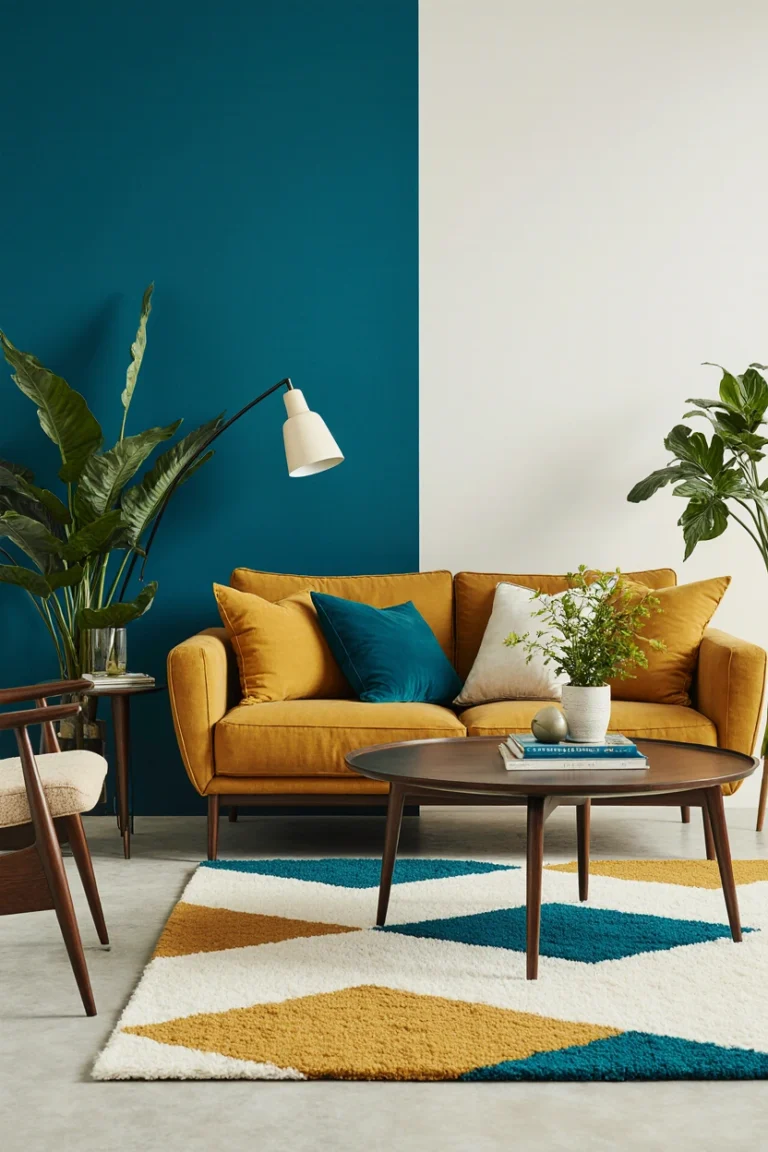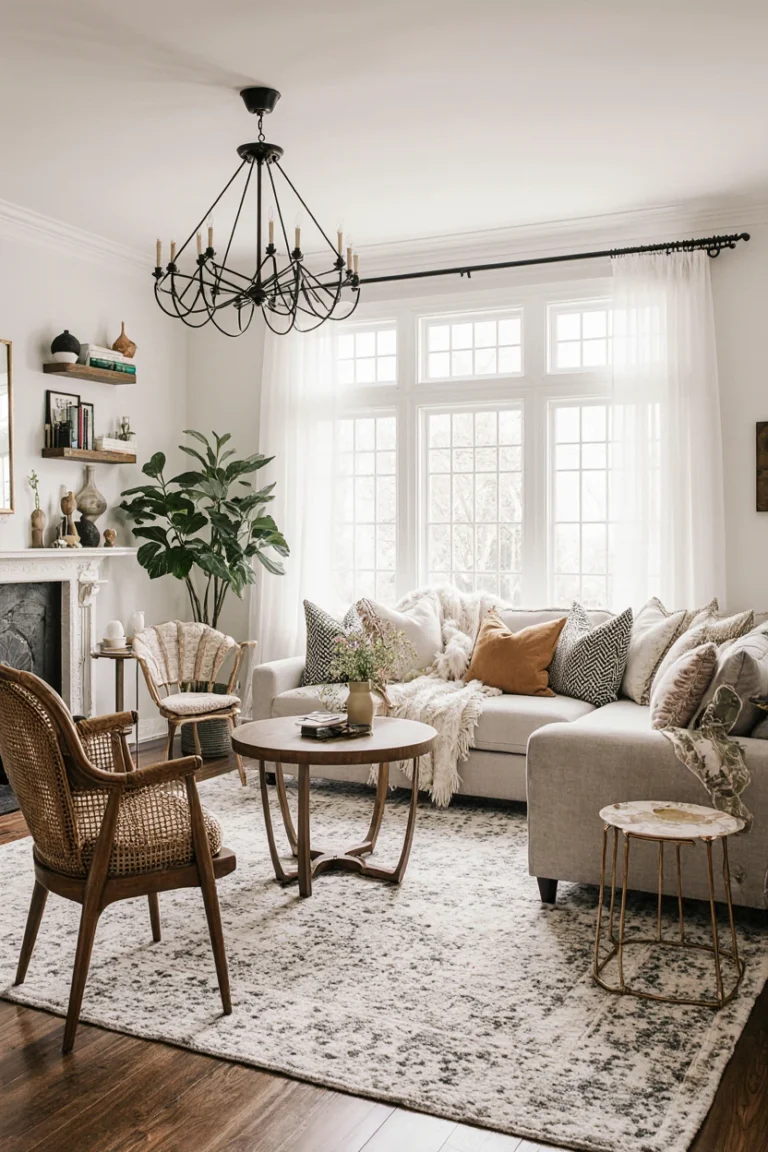Farmhouse Decor: Rustic Styling Tips That Actually Work
Table of Contents
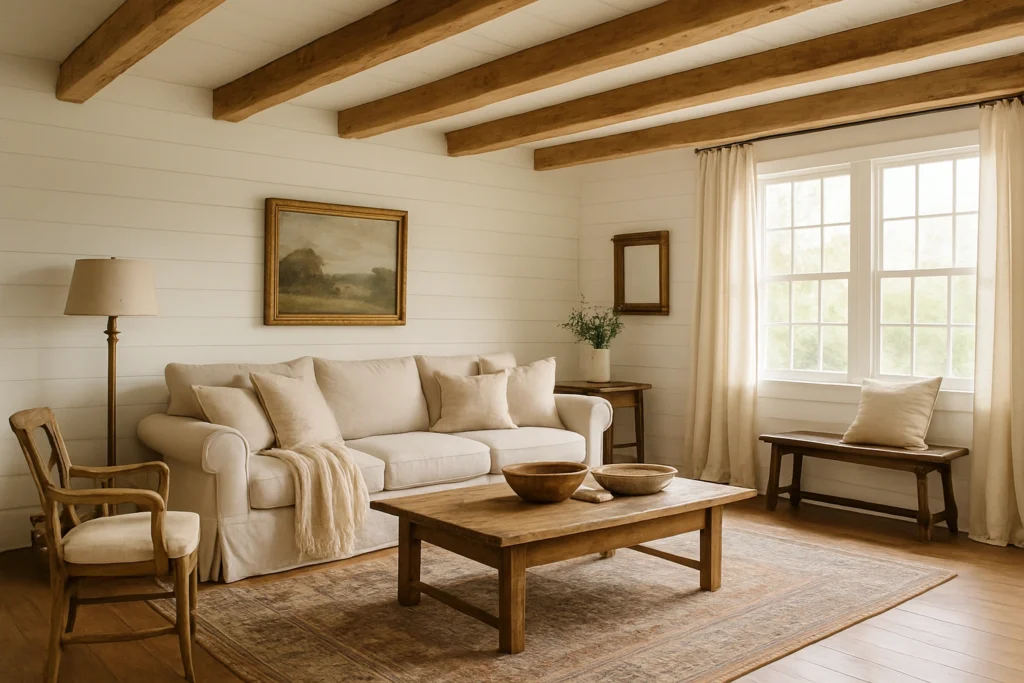
You want your home to feel like a warm invitation — the kind of place where friends linger over coffee, where quiet mornings and slow evenings are celebrated. Farmhouse decor isn’t about copying a catalog photograph or following a single trend; it’s about choosing pieces, textures, and rhythms that tell a story, that age with grace, and that make your life feel calmer and more rooted. In the pages that follow you’ll find practical, soulful ways to bring rustic charm into everyday rooms without turning your space into a theme. You’ll learn how to mix old and new, prioritize comfort and craftsmanship, and make tasteful choices that reflect your life — not someone else’s Pinterest board.
This guide is written for American homes and for people who want substance over hype. Expect clear principles you can apply room by room, hands-on styling exercises you can finish in an afternoon, and a little cultural context so you understand why certain materials and shapes feel right. Throughout, I’ll use farmhouse decor and related ideas to guide choices that actually work in real life — practical, elegant, and unmistakably yours.
discover your personal decor style
How to use this article
If you want the big picture, start with Style Principles. If you prefer practical, hands-on tips, jump to Room-by-Room or the Step-by-Step Styling Guides. Use the Printable Checklist & Room Planner near the middle to keep track of swaps you want to try. Read straight through for a full, flowing approach that ties history, materials, and visual strategy together — or skip to the section that best fits what you want to do this weekend.
Style Principles — the heart of farmhouse decor
What makes farmhouse decor feel authentic
At its core, farmhouse decor is a conversation between function and feeling. Authentic farmhouse style values objects that look as though they belong in everyday life — furniture built for sitting, tables scarred by meals and homework, textiles that have been washed, patched, and loved. That practicality creates a visual honesty: surfaces with patina, visible joins in wood, and fabrics that invite touch. To make that authenticity read as deliberate rather than accidental, think about texture, proportion, and restraint. Rough-hewn wood sits naturally next to soft linens; a woven basket anchors a corner the way a small painting anchors a wall. You’re not chasing shabby for its own sake; you’re creating a layered environment where each piece has a purpose and a place. When you let function lead the aesthetic, your rooms read as lived-in and comfortable rather than staged.
Core rules you can follow anywhere
There are a few repeatable rules that will serve you whether you live in a farmhouse, a bungalow, or a mid-century apartment. First, start with a calm, neutral base: walls, primary upholstery, and large rugs should act as a serene backdrop that lets texture and small details do the talking. Second, introduce two contrasting textures in every room — perhaps a rough wood table plus a soft, quilted throw. Third, prioritize scale and comfort: furniture should feel as if it invites use, not just admiration. Fourth, repeat materials or shapes to build cohesion — the same warm wood tone in picture frames, a mirror frame, or a shelf will quietly unify a space. Fifth, leave breathing room; farmhouse decor thrives on edited, intentional clutter, not visual chaos. Finally, keep a sense of balance between polished and patinaed surfaces — a glazed ceramic vase will sing against an unfinished bench. Apply these rules as gentle constraints, not laws: they help you make decisions quickly and with elegance. For instance, in a living room you might choose a neutral sofa (base), a jute rug and a linen throw (two textures), a low coffee table that invites reach (scale), and repeat a dark metal tone in lighting and hardware (repetition).
Style comparisons: farmhouse vs. modern farmhouse vs. rustic vs. traditional farmhouse
Different home decor styles / explore other popular styles
Farmhouse, modern farmhouse, rustic, and traditional farmhouse share DNA, but they emphasize different notes. Classic farmhouse centers on the domestic: broad tables, slipcovered seating, and a balance of function and warmth. Rustic leans into raw materials and a stronger sense of untamed texture — think heavier beams, rough stone, and more rugged furniture. Modern farmhouse pares back: cleaner lines, minimal ornament, and an emphasis on lightness while keeping tactile materials. Traditional farmhouse decor is where regional history shows up — antique bedframes, pattern in textiles, and a slightly more formal approach to layout. How to pick your mix? Ask yourself: do you prefer softer lines or rugged surfaces? Do you entertain often or favor quiet family life? How much maintenance do you want? If you want a lighter, airier feel choose modern farmhouse; if you’re drawn to history and heirlooms, tilt toward traditional farmhouse; if you want wilderness-adjacent honesty, favor rustic. A thoughtful blend often works best — a modern sofa with an antique pine table or a reclaimed bench softened by linen cushions.
Mid Century Modern Decor Ideas to Elevate Your Space
The Ultimate Guide to Coastal Home Decor Styles
How to pick your mix (quick diagnostic)
- If you entertain often and favor clean spaces → modern farmhouse.
- If you value heirlooms and history → traditional farmhouse.
- If you love raw texture and the outdoors → rustic.
- If you want comfort and everyday practicality → classic farmhouse.
Color, scale & proportion
The farmhouse palette is calming because it’s rooted in nature: warm whites, soft creams, muted greens, and charcoal anchors. These colors allow texture and form to take center stage. Use a warm neutral for walls to create an embracing backdrop, then layer in muted greens or deep charcoal for grounding accents. Scale matters: choose area rugs and furniture that make rooms feel generous — large rugs visually expand a seating area; a substantial table invites gathering. Lighting is also a matter of scale and mood: combine ambient overhead light with task lamps and softer table lamps to create layers. When you introduce a bold accent, use it sparingly — one deep blue or rust cushion, a single painted door, or a row of small accent objects can reset the room without overpowering the farmhouse calm. Proportionally, favor furniture that sits low to mid-height for living areas, allowing sightlines to remain open and rooms to feel welcoming rather than boxed in.
Room-by-Room: Farmhouse home decor ideas that actually work
Living Room — rustic home decorations for gathering
In the living room, aim for a comfortable layout where conversation and relaxation are the priority. Anchor the space with a sofa of simple silhouette — slipcovered or upholstered in a linen-like fabric — and pair it with chairs or stools that invite movement. Layer a textured rug beneath a well-worn coffee table or a reclaimed wood top; add throws and pillows that echo the room’s palette and introduce tactile contrast. A fireplace or a warm focal wall gives the room heart: frame it with a curated gallery of family photos, vintage botanical prints, or simple mirrors in wooden frames. Balance antiques with contemporary pieces by repeating tones and textures — a modern lamp on an antique side table reads as intentional when the metal finish appears elsewhere in the room. Lighting should be soft and layered: an overhead fixture for general use, task lamps for reading, and small accent lamps for a cozy evening glow. To build a cozy vignette, group objects in odd numbers and vary heights: a tall vase beside stacked books and a small bowl creates rhythm and intimacy. Keep surfaces practical — a tray on the coffee table corals smaller items and keeps the lived-in look tidy.
Quick swap: textiles
Swap one room’s textile trio to refresh the look: 1) Replace a thin throw for a thicker, textured blanket; 2) change two pillows to complementary tones and patterns; 3) add a woven floor cushion or pouf for additional texture and seating. These three swaps alter color, texture, and scale with minimal cost and effort.
Kitchen — functional charm, not clutter
Kitchens are where farmhouse practicality shines. If you have open shelving, style it with everyday items that are also beautiful — neatly stacked plates, simple jars for dry goods, and a few small ceramic bowls. Keep the display curated and easy to maintain: one or two rows per shelf, a repeating motif such as white plates or glass jars, and a few pots or woven baskets for soft contrast. If closed cabinetry is your choice, use open surfaces to suggest the same warmth: a wooden bowl of seasonal fruit, a cutting board propped at the back of the counter, or a vase of fresh herbs. Function is part of the aesthetic — the items you use daily can be part of the decor without becoming clutter. For a small styling exercise, choose one shelf and pare it to three groupings: a stack of plates, a set of jars, and a small, low plant. Keep items in consistent tones and avoid mixing too many materials in one view.
Styling open shelves — mini step-by-step
- Remove everything and clean the shelf.
- Group items in threes or odd numbers.
- Use repetition (white plates, clear jars) to build rhythm.
- Add a soft element (a small plant or woven basket) to warm the display.
- Step back and edit — remove anything that reads as clutter.
Dining Room — a table that invites lingering
A farmhouse dining room is less about formal staging and more about hospitality. Choose lighting that creates a warm pool of light over the table — a pendant or layered fixtures that lower the ceiling visually. Layer the table with a neutral runner or a simple linen cloth when you want softness; leave it bare when you prefer a rugged, casual look. Centerpieces should be approachable and change with the seasons — a low cluster of candles and sprigs in autumn, a shallow bowl of citrus in winter, a loose bouquet in spring. Combine heirloom chairs with simple bench seating to create an inviting mix of formality and ease. When setting the table, think of texture: woven placemats, simple linens, and an element or two that feels hand-made will keep things relaxed and authentic. The goal is to design a table that makes diners want to stay.
Bedroom — calm, textured retreat
Your bedroom should feel like a quiet pause in the day. Start with bedding that emphasizes comfort — soft sheets and a duvet that invites rest. Layer with blankets and quilts in complementary textures and patterns for depth. Keep bedside tables functional: a lamp for reading, a small tray for essentials, and perhaps a book or an object that feels personal. Window treatments should soften light but keep a light, open feeling; linen curtains or simple shades diffuse sun and add warmth. Keep a sense of symmetry where it matters — balanced bedside lighting or matched bedside tables — then personalize with unique textiles or a vintage mirror. For a small vignette of calm, place a low reading chair in a corner with a soft throw and a narrow side table to make a private nook.
One simple vignette
- Nightstand styling — start with the essentials: lamp, small tray, and a personal object. Place a small stack of books, top with a small ceramic cup or a framed photo. Keep everything within arm’s reach.
- Textural layer — add a folded blanket at the foot of the bed and a textured cushion to the chair. Let one pattern be your accent while the rest stays neutral.
- Lighting and reflection — add a small mirror or a framed print above the nightstand to catch light and bring a finished feel to the vignette.
Bathroom — small spaces, big impact
Farmhouse bathrooms win through materiality and careful restraint. Swap harsh, clinical lighting for softer bulbs and layered sources when possible; bring in natural textures like woven baskets for towels, a wooden stool that holds a folded towel, or a vintage mirror with a warm frame. Storage should hide what can’t be beautiful and display what can: rolled towels in a woven basket, glass jars for cotton rounds, a small plant for life. Keep counters clear by designating one tray for daily items and hide the rest. In small bathrooms, a single well-chosen framed print or an antique mirror can shift the tone from functional to restful. Texture and tactility turn a small utilitarian room into a gentle retreat.
Entryway & Mudroom — country decorations for home’s first impression
The entry is where your style gets announced, and farmhouse charm is especially welcoming here. Choose a bench for putting on shoes, a set of hooks for coats, and baskets for seasonal gear. A mirror near the door adds depth and light, while a simple rug sets a practical tone. Keep daily practicality forefront: a designated drop zone for keys and mail keeps the look tidy. Personal touches — a framed vintage print, a bowl for loose change, or a small planter — make the entry feel cared for. The goal is a space that signals hospitality and order: usable beauty that doesn’t slow you down as you come and go.
Home Office / Nook — comfortable, functional styling
To bring farmhouse character into a workspace, prioritize a comfortable, durable desk and task lighting that reduces strain. Use storage that looks good while hiding cables — a simple basket for cords, closed cabinets for reference material, and a cork or fabric board for inspiration that tacks up swatches and photos. A reclaimed wood desk or a table with visible grain instantly warms a workspace; pair it with an ergonomic, upholstered chair to bridge function and comfort. Keep desktop clutter to a minimum by creating homes for everything: a small tray for pens, a vertical file for current projects, and a soft throw for chilly mornings. The result should be a space that supports work but rewards pause.
Outdoor & Garden: Farmhouse rustic home decor outdoors
Porch, entry, and patio ideas
Extend your farmhouse aesthetic outdoors with durable textiles, layered seating, and plentiful planters. A covered porch becomes an outdoor room with layered rugs, lanterns that read well in daylight and at night, and seating arranged for conversation. Choose plantings that feel domestic and generously planted beds that read as cultivated rather than manicured: lavender, hydrangeas, simple herbs, and long-blooming perennials. Use planters in varied heights — a tall container planted with a dramatic grass beside a low pot of thyme or rosemary invites close-up scent and color. Seasonal touches — a woven wreath in autumn, sheafs of wheat in winter, or a simple garland in spring — keep the porch in step with the year without becoming fussy.
Garden accents & country decorations for home landscapes
Small garden accents carry a lot of farmhouse personality: a reclaimed wood sign, a weathered wheel propped against a fence, a low stone border, or handmade plant markers. Create small seating niches with a simple bench and scatter cushions, and use gravel or stepping stone paths to lead the eye. Salvaged materials have charm: an old ladder can become a trellis, and a worn bucket can be a planter. Use scent to extend the interior experience — jasmine near a porch step or thyme under a kitchen window offers an olfactory welcome that blends indoors and out. Keep scale human and approachable; a garden should feel like a series of rooms that invite you to pause.
Low-maintenance strategies
If you want the farmhouse decor look without constant upkeep, favor hardy plants and weatherproof textiles. Choose native or drought-tolerant perennials, group plants by water needs, and use mulch to reduce weeding. Opt for simple, durable cushions and remove them during storms, or use a small storage trunk to house textiles when they’re not in use. Embrace materials that age gracefully: a rusted planter will develop character; a cedar bench will silver over time in a way that reads intentional rather than neglected. The secret to a relaxed outdoor aesthetic is choosing elements that improve with time rather than demand replacement.
Step-by-Step Styling Guides (practical projects you can finish in an afternoon)
How to build a farmhouse vignette — step-by-step
Before you begin, decide the story you want the vignette to tell: a quiet reading moment, a seasonal welcome, or a set of objects that reflect family history. A vignette should balance height, weight, and texture.
- Clear the surface and start with a grounding object — a tray, a low bowl, or a stack of coffee table books.
- Add a taller element — a vase, candlestick, or a framed picture set slightly behind the tray.
- Introduce a medium element to bridge the two — a small plant, a ceramic cup, or a small wooden box.
- Place one small, personal object for intimacy — a found shell, a family photo, or a handwritten note framed in a tiny frame.
- Create negative space — leave a portion of the surface uncluttered to let the vignette breathe.
- Edit: remove the least interesting item and step back to see if the grouping reads cohesive.
This approach ensures that the vignette reads as curated rather than piled, with each object contributing to a unified mood.
How to refresh a room with one budget swap
Pick one element to change — textiles, lighting, or a focal surface — and commit to a small set of moves. For example, if you choose textiles: replace a thin throw with a chunky knit, swap two pillows for richer textures, and layer a small rug at the foot of the bed or in front of a chair. If lighting is your swap, change a cool overhead bulb for a warm one, add a table lamp to a dark corner, and introduce candlelight for evening ambiance. The key is to change three small things that affect color, texture, and light together — that triad shifts a room more than a single change on its own.
How to mix old and new without feeling disjointed
Mixing periods is an art of tonal and material linking. Start by choosing one unifying element — a color, a metal finish, or a wood tone — to repeat across the room. Place new pieces where durability matters (a modern sofa with stain-resistant fabric), and allow older items to sit where character is welcome (an antique sideboard or thrifted mirror). Use textiles to soften contrasts: a vintage rug can anchor modern seating, or a new linen throw can make an antique chair feel current. Four practical steps: 1) select a unifying material or color, 2) balance scale (don’t put three heavy antiques against one delicate modern piece), 3) introduce a repeating accent (same metal on lighting and drawer pulls), 4) use textiles to harmonize contrasts.
Small DIY: distressing a wooden frame & making a simple herb planter
Distressing a wooden frame (safety mindful): Sand lightly where natural wear would sit — edges and corners — then use a dry brush to apply a thin wash of paint and immediately wipe most of it back to let grain show through. Finish with a light sanding of raised areas. Work in a ventilated space and wear a dust mask when sanding.
Simple herb planter: Choose a shallow wooden box or a small reclaimed container. Line with a breathable liner, add potting mix, and plant a trio of hardy herbs such as thyme, rosemary, and chives. Place the planter near a sunny window or on an outdoor table. Keep watering minimal and trim for use and appearance.
Both projects are approachable, quick, and add handcrafted personality that reads like authentic farmhouse craft.
Materials, sustainability & sourcing
Choosing materials that age gracefully
Materials that show gentle aging are central to farmhouse decor charm. Reclaimed wood offers a history of use; its knots and small marks tell a story and provide immediate warmth. Natural fibers — linen, cotton, wool — invite touch and soften a room’s edges. Metals that develop patina, such as iron or brass, add warmth without needing polish. When you choose these materials, you’re opting for longevity: they can be repaired, refurbished, or re-finished rather than replaced. Care is simple — dust wooden surfaces with a soft cloth, launder linens gently on low heat, and treat metal patina as a desirable finish rather than damage. With a little attention, these materials cultivate a layered, authentic look over years rather than months.
Sustainable sourcing & provenance
Sourcing with conscience improves both the look and the story behind your home. Ask sellers about the origin of reclaimed pieces, favor local artisans who work with reclaimed materials, and choose second-hand finds that can be restored rather than newly manufactured. Upcycling — repairing and refinishing existing pieces — reduces waste and gives you unique objects with character. When buying new, favor staples crafted well rather than trendy, disposable items. Ethical thrifting and modest restoration are practical ways to combine sustainability with the farmhouse ethic: objects that carry history and promise continued use.
Where to Buy Farmhouse Decor
Finding authentic farmhouse pieces is easier than ever. Whether you love vintage charm or new rustic accents, these trusted retailers offer a wide variety of furniture, textiles, and decorative details to complete your look:
- Wayfair – Large selection of farmhouse furniture and décor at different price points.
- Etsy – Unique handmade and vintage farmhouse items from independent sellers.
- Pottery Barn – High-quality rustic furnishings and accessories with a modern farmhouse vibe.
- Amazon – Budget-friendly farmhouse accents and quick delivery for everyday updates.
Tip: Look for natural materials like wood, linen, and iron to keep your farmhouse style warm and timeless.
History & cultural background of traditional farmhouse decor
Origins and evolution
Farmhouse sensibilities arise from necessity and comfort. Early farmhouse interiors were shaped by regional climates, local materials, and the rhythms of rural work: wide tables for shared meals, durable fabrics for daily use, and multipurpose furniture that worked as hard as the people who used it. English country influences brought pattern (English country decor tips), modesty, and a certain arrangement of rooms devoted to family life; American farmhouse variations adapted these ideas to local timber, stone, and climate — think clapboard houses in the Northeast, broad porches in the South, and practical, center-hearth rooms in colder regions. Over time, farmhouse decor elements moved from rural houses to urban interpretations as people sought warmth and authenticity in built environments. Today’s farmhouse decor mixes that heritage with modern needs: durable textiles, cleaner lines, and accessibility without losing the sense of continuity with the past.
Why patina & imperfection matter
Patina signals use and care: a scuffed table suggests family dinners and homework, a faded quilt shows years of sleep and warmth. Those imperfections soften visual severity and invite touch. Psychologically, imperfect surfaces make spaces feel human and approachable; they resist the sterile perfection of factory finishes. In a farmhouse home, imperfection is not neglect — it is a record of life. When you curate patina, you choose objects that will gain charm rather than degrade; you accept slight irregularities in exchange for depth and narrative.
Conclusion & Key Takeaways
Farmhouse decor is less a look and more a posture: an ethic of comfort, usefulness, and gathered beauty. When you choose materials that age well, prioritize texture, and arrange spaces for real life, your home becomes an invitation rather than a showpiece. Start small if that feels manageable — a small vignette, a softer lamp, or a single reclaimed bench — and let the room evolve. Authenticity grows from doing rather than buying; it’s the small decisions repeated over time that create a home with character.
Six quick takeaways
- Start with a neutral base and build texture.
- Introduce two contrasting textures in every room.
- Repeat one material or finish to unify the space.
- Favor items that age gracefully and can be repaired.
- Edit: leave negative space to let objects breathe.
- Do one practical swap this weekend (textiles, lighting, or one vignette).
Try one small swap this weekend and notice how it changes not just the room’s look but how you use the space.
FAQ — common questions
Q1: What is farmhouse decor?
A: Farmhouse decor blends practical, work-ready pieces with soft, lived-in layers. It emphasizes tactile materials — wood, linen, woven fibers — and objects that read as useful and comfortable. The style values warmth, unpretentious furniture, and a calm palette that lets texture and history do the work.
Q2: How do I make my home feel farmhouse without going overboard?
A: Start small: pick one room and one surface. Add a textured throw, a woven basket, and one reclaimed wood element. Edit ruthlessly so the room feels curated rather than cluttered. Focus on function-first pieces that also look good — that’s the heart of restrained farmhouse decor.
Q3: Is farmhouse style the same as rustic?
A: They overlap but are not identical. Rustic emphasizes raw materials and a stronger wilderness or rugged character; farmhouse centers on domestic comfort and everyday hospitality. You can combine elements of both — a rustic table with softer farmhouse textiles — to strike a balanced look.
Q4: Can farmhouse decor work in an apartment?
A: Absolutely. Scale down key elements: choose lighter woods, smaller rugs, and one or two tactile focal points rather than large, heavy furniture. Use multifunctional pieces and keep storage hidden to preserve calm.
Q5: What quick swaps offer the biggest impact?
A: Focus on three areas at once: change lighting to warmer bulbs and add a lamp, swap textiles (a new throw and a pair of pillows), and style one surface (a coffee table, mantle, or shelf) with a cohesive vignette. These moves affect color, texture, and light together — the triad that transforms a room.


